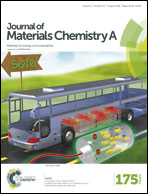Facile synthesis of porous Ni2CO3(OH)2/functionalized graphene composites with enhanced supercapacitive performance
Abstract
Graphene has great potential to significantly enhance the electrochemical activity of redox-active materials for supercapacitors. However, the agglomeration of graphene sheets remains a critical challenge to excellent energy storage performance of hybrid composites supported by graphene. Herein, a facile hydrothermal approach for the synthesis of porous Ni2CO3(OH)2/functionalized graphene (NCB/FGN) composites is developed. To improve the dispersion properties of graphene, sulfonated salicylic acid serving as a functionalized composition is covalently anchored to the surface of functionalized graphene. The systematic investigation indicates that the presence of functionalized graphene plays a crucial role in establishing the porous structure of hybrid composites. Compared to reduced graphene oxide (rGO), functionalized graphene is more beneficial to accommodate the expansion of the surface area and the reduction of the pore length in hybrid composites. The detailed electrochemical characterization demonstrates that the unique porous structure of NCB/FGN composites encompasses the great capability of rapid kinetic diffusion of active ions in electrolytes during the electrochemical reaction. The specific capacitance of NCB/FGN composites is 1508 F g−1 at a current density of 1 A g−1, higher than 1258 F g−1 for NCB/rGO composites and 1039 F g−1 for pristine NCB. After 3000 charge–discharge cycles at a current density of 10 A g−1, the specific capacitance of NCB/FGN composites still approaches their initial capacitance.


 Please wait while we load your content...
Please wait while we load your content...